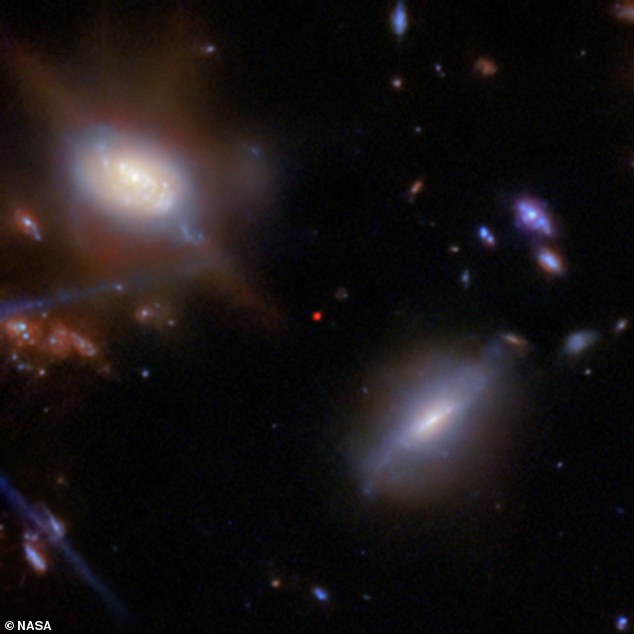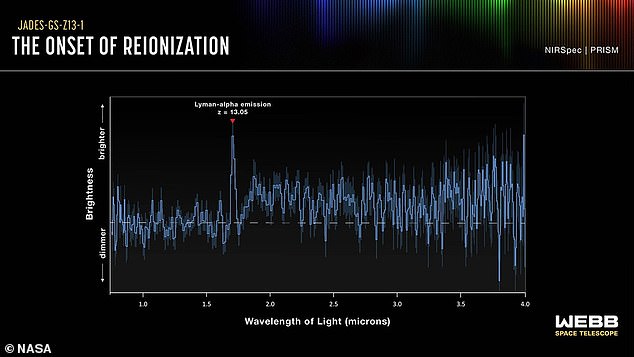- READ MORE: Webb telescope captures images of galaxy that shouldn't exist
NASA 's James Webb Space Telescope (JWST) has captured the earliest evidence of light shining through the cosmos.
An international team of researchers used JWST to observe an ancient galaxy that emitted light just 330 million years after the Big Bang, when a thick fog of neutral hydrogen gas made it difficult for light to cut through the darkness .
This galaxy, called JADES-GS-z13-1-LA , somehow managed to shine even though its light should have been completely absorbed by the dense fog.
JADES is one of the most distant galaxies in the known universe. Its light had to travel nearly 13.5 billion light-years to reach JWST, which also means that this galaxy is almost as ancient as the universe itself.
The farther out in space astronomers look using telescopes like JWST, the further back in time they're seeing, almost all the way to the Big Bang.
What's more, JWST detected a Lyman-alpha emission from JADES, which is a specific, distinctly bright wavelength of light that is very easily absorbed by neutral hydrogen.
The fact that the telescope spotted this emission means that the fog immediately surrounding the galaxy must dissipated, according to the researchers.
This suggests JADES was actively clearing the neutral hydrogen gas away.

'This result was totally unexpected by theories of early galaxy formation and has caught astronomers by surprise,' Roberto Maiolino, co-researcher and astrophysicist at the University of Cambridge and University College London, said in a statement .
The universe began roughly 13.8 billion years ago with the Big Bang. In its early years, it looked completely different than the shining, sparkling cosmos we see today.
Beginning 400,000 years after the Big Bang and lasting hundreds of millions of years, the universe was in a period known as the 'dark ages' when no planets, stars, or galaxies existed.
During this time, only a fog of hydrogen atoms floated around in the darkness.
But around 680 million years after the Big Bang, the first stars and galaxies began to form.
They released ultraviolet radiation into the darkness, initiating the disintegration of hydrogen atoms and progressively making the universe translucent to light.
Over millions of additional years, an increasing number of stars came together and grouped into galaxies.
By 1.1 billion years following the Big Bang, the cosmos transformed from an opaque expanse of darkness into a clear, luminous universe.


However, upon examining the JADES galaxy with JWST’s imaging and spectroscopy tools, the scientists discovered that it originates from the midst of the cosmic dark ages.
Back then, the neutral hydrogen gas would have been so dense that it effectively suffocated any light released by the earliest stars or galaxies.
"We truly shouldn't have encountered a galaxy like this based on our current comprehension of how the universe has developed," stated Kevin Hainline, an astronomer from the University of Arizona and also a co-author, in the press release.
"We might envision the early universe as being enveloped in a dense mist, making it extremely challenging to detect even strong beacons trying to shine through. However, what we observe here is the beam of light from this galaxy slicing through the haze," he explained.
This intriguing spectral line holds significant implications for understanding when and how the universe underwent reionization.
The group released their research in the periodical Nature .
Currently, the researchers do not understand the mechanism or reason behind the emission of Lyman-alpha radiation from this galaxy. However, they do possess certain hypotheses.
A potential explanation could be that JADES contains exceptionally massive, hot stars which are much more effective at generating ionizing radiation compared to an average star nowadays.
In this scenario, these stars might have warmed the nearby gas to over fifteen times the temperature of the Sun's surface, leading to extraordinarily intense radiation emissions.
A different hypothesis suggests that the JADES galaxy hosts an active supermassive black hole, with radiation from matter plunging into this black hole causing the surrounding gas to become ionized.
The research team discovered some supporting evidence for this concept. They found that the measurements indicating the size of JADES suggest it is remarkably small—a trait typical of galaxies hosting black holes.
Despite the manner in which the light from this distant ancient galaxy pierced through the obscurity of the early universe, obtaining these images provides insight into potentially the initial glow emitted by the earliest stars in our universe, according to the scientists.
Read more